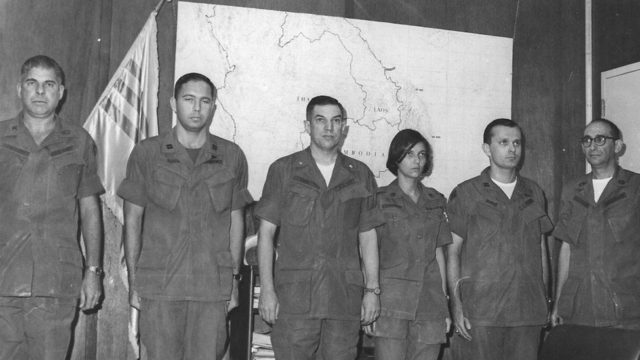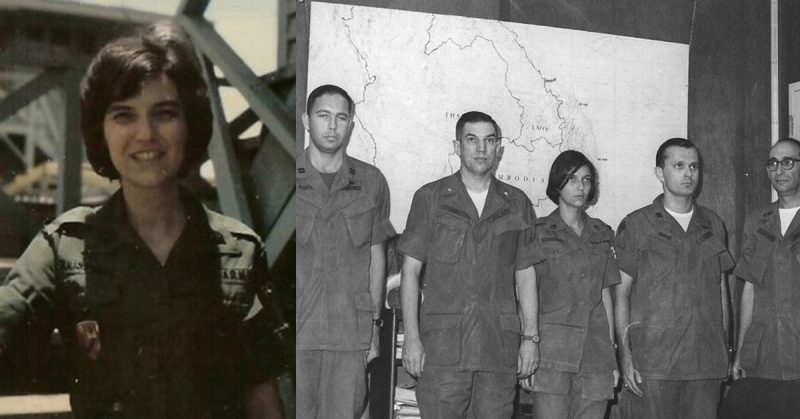In 1963, Claire Brisebois Starnes enlisted in the Signal Corps of the US Army. She was 17 years old and so skinny that she was ordered to eat bananas so that she could gain weight. She volunteered to travel to Vietnam for a tour of duty.
More than 1000 women served in non-combat roles as line and staff officers and enlisted personnel in the US Army, Air Force, Navy and Marine Corps.
Starnes spent 17 years finding the women who served in non-nursing positions. The stories of these women are told in the book Women Vietnam Veterans, Our Untold Stories, by Donna Lowery. Lowery served 26 years in the military, including 19 months in Vietnam. The book is the women’s wall, memorializing the names of the women forgotten for 50 years.
Starnes was a translator before she became a photojournalist and took charge of the publications section at Military Assistance Command Vietnam Office of Information (MACV Observer). ”I went there to see what was going on,” says Starnes. “I had to go and look for myself. I saw it was not the military running the war, it was politicians running the war.”
Starnes carried two cameras. One, a Nikon, was issued by the Army. The other was her own Petri camera. She shot on both Kodak color slide film and on black and white film.
She rode in a helicopter to all parts of Vietnam, sitting on her flak jacket to protect from bullets fired from below.
The photos she took are extreme. There are firefights in fields of mud and bodies, children at orphanages, buildings that have been blown apart, Bob Hope entertaining the troops, WACs during their downtime with rollers in their hair.
”I had no idea how bad it would be. When I took the pictures, I never let myself feel anything,” says Starnes. You had to tune out emotionally. It was only when I got home that I started to realize what I’d seen.”
One photo that stands out to her is of a little girl playing in barbed wire. ”She could have been ripped apart. She seemed so happy at that moment and yet there were craters around. Overall the kids were so resilient, or maybe they didn’t understand the seriousness of it.”

Source: Claire Starnes / US ARMY
By the end of the war, an estimated four million people had died. Most soldiers returning home were heckled and spat on in the airports.
Women were even less likely to talk about their experiences in Vietnam. Most went on with life, careers, and families. They buried their emotions and their memories. Many went to the grave without telling anyone that they had served in Vietnam. All of them know that Vietnam changed their lives, for better or worse.
Starnes served five tours of Vietnam before returning home. She received the Vietnam Service Medal with Silver Star, the Republic of Vietnam Campaign Medal, and the Republic of Vietnam Gallantry Cross. She originally wanted to hide from the memories and focus on her family and her work. Eventually, though, she sought help in group therapy for Vietnam veterans. She was the only female present. The male veterans verbally abused her. She left feeling ashamed and never tried therapy again.
She attended the dedication of the Women in Military Service for America (WIMSA) memorial with fellow veteran Precilla Landry Wilkewitz. They each wore vests with their dates of service on the back, hoping to meet other women who had served in Vietnam. Eventually, they formed the Vietnam Women Veterans (VWV) Inc. non-profit organization.
That’s when they began tracking down other women who served in non-nurse roles in Vietnam. They held a Women Vietnam Veterans Conference in Olympia, Washington. It was the first time the women had been publicly recognized as veterans and thanked for their service.
”When I give my talks to help promote the book I begin with, ‘Hi I’m Claire Brisebois Starnes and I’m a Vietnam War veteran.’ I have only been able to say that since 1997. I didn’t dare say it because no-one really understood. No-one cared, no-one was interested and it hurt too much.”
Source: http://www.bbc.com/news/in-pictures-36574698
